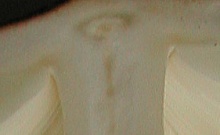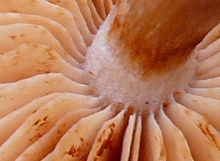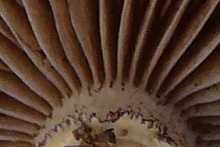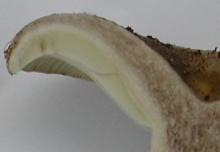question 13: Insertion of gills onto stem
The insertion of gills describes the way gills stick to the stem. There are several type of such insertions (some of them are grouped together below to simplify). The gills can then be:
- "free or adnexed", in this case, the gills are totally free, this means their vertical edge is not adhering at all to the stem, even if it is close;
- "sinuate, emarginate, adnate only through decurrent tooth", in this case, the gills are almost free, but they touch the step on a small portion of their vertical edge, or the height of the gills can decrease to a minimum just after touching the stem;
- "adnate, ascendant", in this case, the gills are attached to the stem by their vertical edge;
- "decurrent or sub-decurrent", in this case, the gills adhere to the stem to form an ark along the stem.
In order to make sure what the type of gill insertion is for a given species, one has to closely look at the precise location where gills and stem meet (magnifying glasses might help for this). One can also make a vertical cross-cut at the middle of the mushroom to check the type of gill insertion.
Examples:

|

|

|

|
|||
| We can see that the vertical edge of the gills does not touch the stem in this example, the gills are therefore free. Select "free or adnexed" in this case | The gills are here almost free, but just after narrowing, close to touching the stem, they go down vertically along it once in contact with it ("decurrent tooth"), select then "sinuate, emarginate, adnate only through decurrent tooth" in this case | In this example, the gills touch the stem on their full height, select then "adnate, ascendant" in this case | The gills here descend from the cap down the stem, on a long portion of it. The gills are therefore decurrent. Select then "decurrent or sub-decurrent" in this case |

Return to identification form